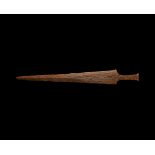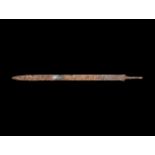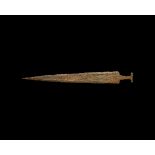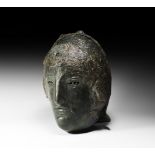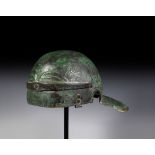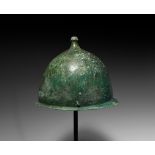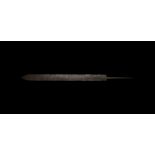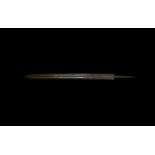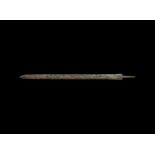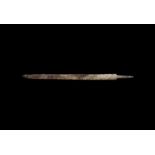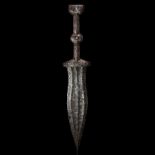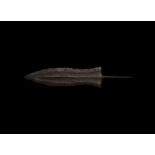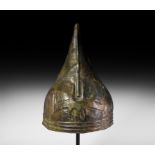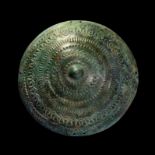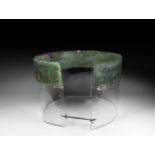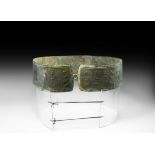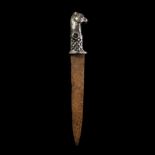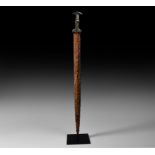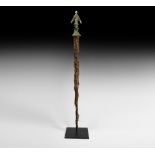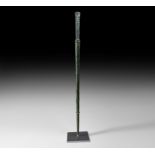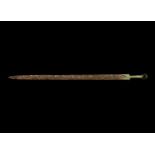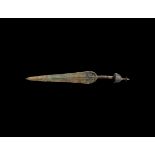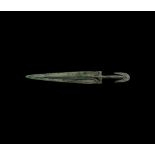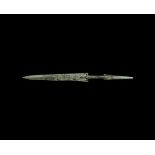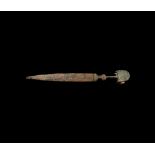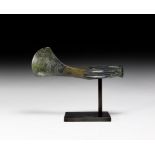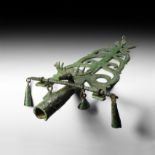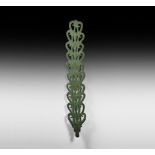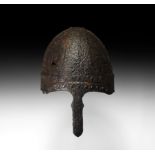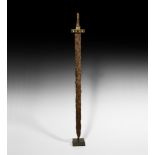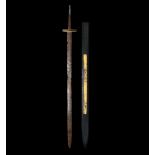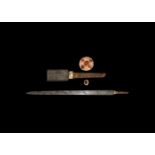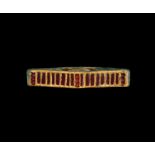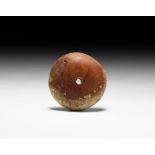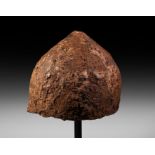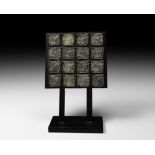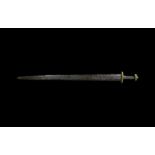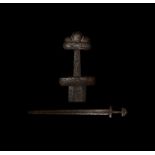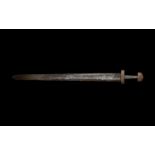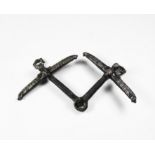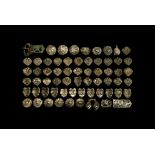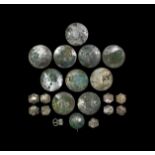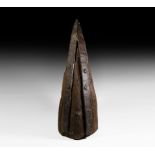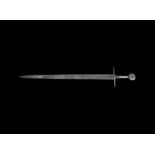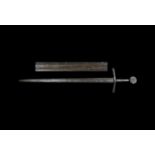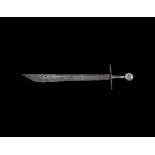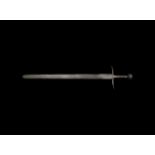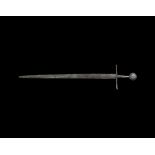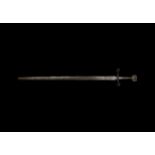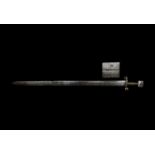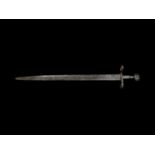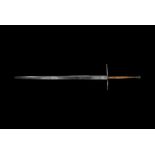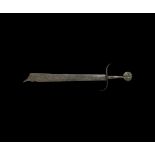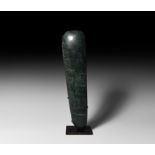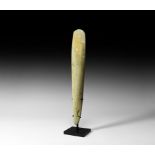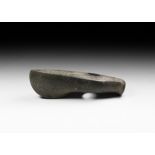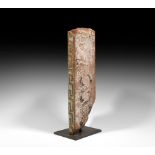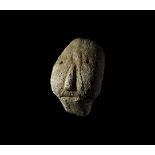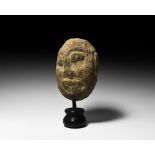Refine your search
Estimate
Category
- Jewellery (143)
- Collectables (92)
- Arms, Armour & Militaria (65)
- Sculpture (61)
- Greek, Roman, Egyptian & Other Antiquities (58)
- Taxidermy & Natural History (22)
- Books & Periodicals (20)
- Ceramics (14)
- Metalware (10)
- Salvage & Architectural Antiques (10)
- Chinese Works of Art (9)
- Coins (8)
- Glassware (8)
- Russian Works of Art (7)
- Ethnographica & Tribal Art (6)
- Islamic Works of Art (4)
- Musical Instruments & Memorabilia (3)
- Scientific Instruments (3)
- Silver & Silver-plated items (3)
- Vintage Fashion (3)
- Carpets & Rugs (2)
- Kitchenalia (2)
- Clocks (1)
- Furniture (1)
- Lighting (1)
- Prints (1)
- Sporting Memorabilia & Equipment (1)
- Stamps (1)
- Textiles (1)
Filtered by:
- Item Type
- List
- Grid
A subscription to the Price Guide is required to view results for auctions ten days or older. Click here for more information
4th century BC. An iron akinakes sword of Central Asian typology, strong hilt, narrow ogival guard with Steppe style ornamentation, tipped hilt, t...
Sarmatian Spatha Sword
4th-5th century AD. An iron two-edged longsword or spatha with lentoid-section blade, shoulder slightly flared, tapering neck and narrow tang with...
4th century BC. An iron akinakes sword of Central Asian typology, strong hilt, narrow ogival guard incorporated in the blade, tipped hilt, triangu...
Late 2nd-early 3rd century AD. A complete bronze female type sports mask of Robinson's Type E and of Mater Castrorum type, composed of two parts: ...
1st-2nd century AD. A relatively heavy bronze legionary helmet, consisting of embossed skull and wide neck-guard with flanged ear-guards, traced e...
1st century BC-1st century AD. A relatively light bronze legionary helmet with bulbous domed bowl, small crest knob with flattened top, pierced at...
Roman Gladius Long Sword
Mid 1st-mid 3rd century AD. A double-edged iron sword of Pompeii typology with parallel cutting edges tapering towards the triangular point, battl...
Circa 300 AD. A double-edged spatha long sword of Illerup-Wyhl typology with excellently preserved blade, three blood channels running along its l...
Roman 'Herulian' Spatha Sword
5th-7th century AD. A double-edged spatha with a parallel-sided iron blade and well preserved pointed tip; battle nicks on both cutting edges; the...
Eastern Roman Spathion Sword
9th-11th century AD. An iron spathion sword with long, double-edged parallel blade, a tapering, medium length tang, retaining possible remains of ...
1st century BC-1st century AD. An iron military pugio dagger of period II, with prominent and rich decoration, comprising a short lanceolate blade...
Roman Pugio Dagger
Mid 3rd century AD. An iron short dagger or pugio of 'Kunzing Type', with double-edged blade, the blade characteristically leaf-shaped with pronou...
Early 8th century BC. A broad hammered bronze helmet of conical form, produced from a single sheet of metal, the front with a raised linear motive...
North West Persian Shield Tondo
Early 1st millennium BC. A domed sheet-bronze shield panel with raised carinated knop to the centre, concentric bands of repoussé ornament includi...
8th-7th century BC. A broad hammered bronze military belt or cuirass band, the register decorated in chased low-relief with hunting scenes includi...
7th century BC. A broad hammered bronze military belt or cuirass band, the register decorated in chased low relief with hunting scenes including g...
Achaemenid Silver Hilted Dagger
6th century BC. An iron dagger with hilt clad in sheet-silver and shaped as the head and neck of a horse, the mane of the horse in low-relief, lar...
Luristan Sword with Bronze Hilt
13th-7th century BC. An iron short sword with slender double-edged blade and pointed tip; bronze handle with narrow lower guard with incised chevr...
8th-7th century BC. A long sword with double-edged iron lentoid-section blade, bronze hilt with scooped lower guard, three beaded collars, pommel ...
Urartian Socketted Javelin
6th century BC. A bronze long javelin with slender rectangular-section blade, three raised bosses to base; tubular tapering socket with herringbon...
Luristan Sword with Bronze Hilt
13th-6th century BC. A sword comprising a two-edged lentoid-section iron blade with rounded tip, narrow shoulders encased in a bronze sleeve exten...
Sword with Blood Channels
2nd millennium BC. A substantial bronze short sword with broad triangular, double-edged blade and central midrib; crescent guard to the shoulders;...
1st millennium BC. A substantial bronze sword with leaf-shaped blade with rounded shoulders, raised midrib with fullers and curved ends extending ...
1st millennium BC. A bronze short sword comprising a broad triangular two-edged blade with median panel developing to a midrib above the point, lo...
8th-7th century BC. A sword with leaf-shaped iron blade, double-waisted grip with transverse collar, the pommel formed as two crescentic iron spay...
12th-8th century BC. A bronze axehead with elliptical ribbed socket and short curved butt, blade with swept lower edge; engraved decoration to bot...
4th century BC. A large bronze standard finial with pierced central plate forming scrolls along central spine with incised ornament and surmounted...
4th century BC. A bronze openwork horse frontlet with the lower part shaped as a stylised head of a horse, incised detail to front surfaces includ...
6th-7th century AD. A segmented iron helmet formed from overlapping and rivetted sheets, two upper bands forming a cross running front-to-back and...
5th century AD. A double-edged sword with broad pointed tip, battle nicks to both cutting edges and traces of scabbard to blade; the gilt lower gu...
5th-6th century AD. An iron two-edged cavalry spatha sword with a parallel-sided blade with broad pointed tip, battle nicks to both cutting edges;...
6th century AD. A spatha longsword and scabbard fitting; the iron blade lentoid in section with parallel edges and tapering tip, formed by the for...
4th-5th century AD. An iron two-edged sword with parallel-sided blade with pointed tip, battle nicks to both cutting edges; the tang retaining one...
5th century AD. A bronze lower guard from a longsword, scaphoid in plan with remains of gilding to the surface; shallow ellipsoid recess to the up...
5th-6th century AD. A substantial polished amber bead shaped as a rounded circular disc with flat back, centrally pierced. Cf. Menghin, W., The Me...
Norman Four-Plate Helmet
11th-12th century AD. A Norman or Cuman four-plate iron helmet constructed from curved triangular sections converging at the apex; the bowl contou...
8th-10th century AD. A group of twelve square silver-gilt plaques from a belt or baldric, each with a low-relief Borre Style pair of 'gripping bea...
10th century AD. A superb Anglo-Scandinavian double-edged cutting sword of Petersen Type L or O variant, straight tapering blade with rounded poin...
10th-early 11th century AD. A double-edged cutting sword of Petersen Type S variant and Wheeler Type III with long tapering blade, battle nicks to...
Viking Sword with Inlaid Hilt
Early 10th century AD. An iron Viking period sword comprising a broad double-edged blade of Peirce's Type 1 with shallow fullers and rounded tip; ...
Viking Silver Inlaid Horse Bit
9th-11th century AD. An iron horse bit comprising two square-section bars joined at the centre with loops, at each outer end two rings inlaid with...
9th-10th century AD. A group of sixty-two silver belt fittings comprising a buckle with pentagonal plate decorated with spiral twigs; thirteen fit...
8th-9th century AD. A large group of substantial silver horse harness fittings from the Khazar Empire, composed of ten round phalerae, presumably ...
Medieval Battering Ram Tip
14th-15th century AD. A large and heavy tip of a battering ram formed from a mature tree trunk, trimmed to a point and fitted with a blacksmith-ma...
Mid 11th-mid 13th century AD. An iron sword with two-edged blade, gently tapering profile with rounded point, shallow fuller, parallel-sided strai...
12th-early 13th century AD. A western long double-edged sword with tapering blade, the cutting edges with evidence of use on the battlefield; both...
13th century AD. An iron falchion with single-edged, asymmetric blade, with short back edge, surface littered with one hole and some signs of corr...
Medieval Single-Handed Sword
14th-15th century AD. An iron sword of pre-schiavonesca type with straight blade, no fullers, round tip, the S-curved cross-guard of 12a type, tap...
15th century AD. An iron double-edged sword of Oakeshott Type XVIIIa with fairly slender blade of flattened diamond-section form, narrow fuller, h...
Medieval Schiavonesca Type Sword
15th century AD. A bastard or hand-and-a-half sword of the schiavonesca type; blade with battle-nicks to both faces and parallel-sides with rounde...
Mid 15th century AD. A long-bladed sword of schiavonesca type with broad double-edged blade, parallel-sided with long triangular point and acute t...
15th century AD. An iron schiavonesca type Z sword with parallel double-edged blade of lenticular section, with rounded tip, slightly enlarged at ...
Late 16th century AD or earlier. A colossal two-handed sword, possibly of German workmanship, straight double-edged blade with wide and shallow bl...
Tudor Falchion with Stamped Tang
Late 16th century AD. A single-edged, heavy cross-section late falchion, the iron blade without fuller to each face; possible maker's mark made of...
Huge Stone Age Polished Axehead
Neolithic Period, 5th-3rd millennium BC. A very large and superbly polished veined greenstone axe of lentoid section, slightly convex cutting edge...
Later 3rd millennium BC. A superb knapped and polished mudstone axehead, tongue-shaped in profile with pointed butt; mounted on a custom-made stan...
Late 3rd-early 2nd millennium BC. A large and finely polished boat-shaped axe in dark grey stone, with expanded asymmetric convex cutting edge tap...
Mid 6th-mid 5th century BC. A carved ceramic fragment with white slip and black pigment field to the lateral flange; white vertical band with pain...
2nd century BC-2nd century AD. A broadly D-section carved quartz monzonite votive head with small, circular eyes, tapering D-section nose, thin mo...
3rd century BC-1st century AD. A carved granite head with reserved facial features and lateral lobe ears, almond-shaped eyes and columnar nose, el...

